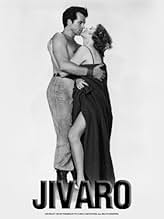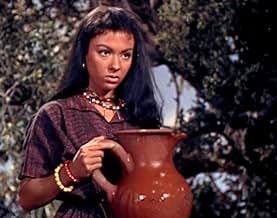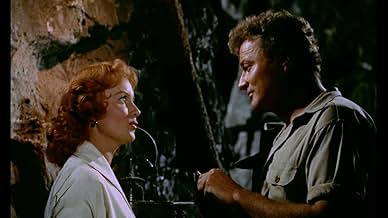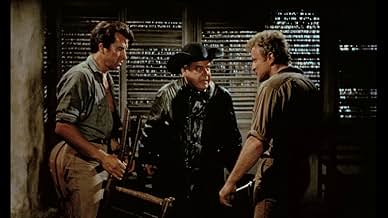IMDb-BEWERTUNG
5,9/10
469
IHRE BEWERTUNG
Füge eine Handlung in deiner Sprache hinzuA gorgeous American arrives in Brazilian headhunter country seeking her scapegrace fiancé.A gorgeous American arrives in Brazilian headhunter country seeking her scapegrace fiancé.A gorgeous American arrives in Brazilian headhunter country seeking her scapegrace fiancé.
- Regie
- Drehbuch
- Hauptbesetzung
Lon Chaney Jr.
- Pedro Martines
- (as Lon Chaney)
Pascual García Peña
- Sylvester, Rio's aide
- (as Pascual Pena)
Charles Lung
- The Padre
- (as Charlie Lung)
Eugenia Paul
- Native Bit
- (Unbestätigt)
Rosa Turich
- Native Bit
- (Unbestätigt)
Richard Bartell
- Locket Native
- (Nicht genannt)
Gregg Barton
- Edwards
- (Nicht genannt)
Delmar Costello
- Bit
- (Nicht genannt)
Jerado Decordovier
- Native
- (Nicht genannt)
Kay Johnson
- Umari
- (Nicht genannt)
Empfohlene Bewertungen
1953's "Jivaro" was shot in color and Widescreen 3-D on location in Brazil as "Lost Treasure of the Amazon" or "Valley of the Winds," produced by the Pine-Thomas unit at Paramount, remembered for their frugality as 'The Two Dollar Bills.' Fernando Lamas toplines as Rio Galdez, a tradesman and bar owner dealing in the upper reaches of the Amazon while discouraging talk of vast riches deep in Jivaro country, the land of headhunters, as a shrine to their victory over the Spaniards. Into this heated background comes Rhonda Fleming as Alice Parker, expecting to wed her long absent fiancee after two years of waiting in California, instantly an object of desire for fortune hunting Tony (Brian Keith), who also covets the hidden treasure. 3-D thrills are plentiful, enough to offset the expected love triangle, with spears, arrows, and other objects hurled at the camera, saving the dangerous trek through the jungle for the final third (the 'Valley of the Winds' certainly earns its nickname). Apart from the handsome leads, supporting cast members are only on screen a short time, including Richard Denning as Alice's doomed beau, Marvin Miller in brown makeup as a native chief, and Lon Chaney as trader Pedro Martines, around just long enough for some good natured sparring with Rio over a worthless crate filled with rocks. This was easily the least of Chaney's films for Pine-Thomas, previously doing major villains opposite Randolph Scott in "Albuquerque" and John Payne in "Captain China."
Adventure n. 1 an unusual, exciting, and daring experience. 2 excitement arising from danger or risk.
While you could argue that Alice Parker's (Rhonda Fleming) initial journey to the Amazon trading outpost to reach her fiance meets the above requirements for an adventure, that part of her story isn't shown on screen. In fact, the only real adventure here takes place in the final twenty-five minutes. But what a glorious twenty-five minutes! A rope bridge over a raging river, dense jungle foliage with all the layering you could dream of, windswept ruins, hostile natives shooting flaming arrows at the camera: it's exactly what I wanted when I first heard about Jivaro.
The preceding hour-and-a-bit, quite frankly, isn't what was advertised. In fact, it's dramatically quite anaemic. The superbly underplayed romance between Alice and Rio (Fernando Lamas) would be perfect as a secondary plot element if the main story-her quest to find her fiance-had any weight. But it rarely does. And the conflict, provided by lascivious prospector Brian Keith, peaks during a bruising fist-fight but then gets swept up in the final expedition and promptly loses its steam.
As with several of these Golden Age 3-D films, I had to watch Jivaro twice, the first time for what it wasn't, the second time for what it was. On second viewing, I surrendered to the leisurely pace and found I could luxuriate in the sumptuous stereography, colourful production, fine acting, and the imaginative evocation of this Amazon setting on the studio backlot. You could say I jived with Jivaro and became a fan. Plus, I just love the 1950's Technicolor feel.
The 3-D is wonderful throughout. You're always conscious of it but never distracted by it, apart from the flying arrows and such near the end. It reminded me of the intuitive, naturalistic 3-D in Miss Sadie Thompson, which was strong without being ostentatious. The layering of dripping water in Alice's room when the rainstorm hits is one of my favourite effects: it's gritty and dream-like at the same time, and absolutely puts you inside the room with her. The sheeting rain outside is also great, as is the smoke in the saloon. There are several instances of characters jumping into the frame from negative space-remember Igor in House of Wax-and they work every time.
The film fulfils its 3-D action-adventure potential and then some as it reaches the finale, first with the rope bridge sequence and then, one of my favourites of any Golden Age 3-D blu-ray, the Valley of the Winds sequence. It's so exotic and striking and dangerous-looking, it kicks the film up several gears. Combined with the sound effects and some clever stereo touches-raging water, a swaying corpse, the positioning of the actors-it's transportive in all the ways I want a movie adventure to be.
While you could argue that Alice Parker's (Rhonda Fleming) initial journey to the Amazon trading outpost to reach her fiance meets the above requirements for an adventure, that part of her story isn't shown on screen. In fact, the only real adventure here takes place in the final twenty-five minutes. But what a glorious twenty-five minutes! A rope bridge over a raging river, dense jungle foliage with all the layering you could dream of, windswept ruins, hostile natives shooting flaming arrows at the camera: it's exactly what I wanted when I first heard about Jivaro.
The preceding hour-and-a-bit, quite frankly, isn't what was advertised. In fact, it's dramatically quite anaemic. The superbly underplayed romance between Alice and Rio (Fernando Lamas) would be perfect as a secondary plot element if the main story-her quest to find her fiance-had any weight. But it rarely does. And the conflict, provided by lascivious prospector Brian Keith, peaks during a bruising fist-fight but then gets swept up in the final expedition and promptly loses its steam.
As with several of these Golden Age 3-D films, I had to watch Jivaro twice, the first time for what it wasn't, the second time for what it was. On second viewing, I surrendered to the leisurely pace and found I could luxuriate in the sumptuous stereography, colourful production, fine acting, and the imaginative evocation of this Amazon setting on the studio backlot. You could say I jived with Jivaro and became a fan. Plus, I just love the 1950's Technicolor feel.
The 3-D is wonderful throughout. You're always conscious of it but never distracted by it, apart from the flying arrows and such near the end. It reminded me of the intuitive, naturalistic 3-D in Miss Sadie Thompson, which was strong without being ostentatious. The layering of dripping water in Alice's room when the rainstorm hits is one of my favourite effects: it's gritty and dream-like at the same time, and absolutely puts you inside the room with her. The sheeting rain outside is also great, as is the smoke in the saloon. There are several instances of characters jumping into the frame from negative space-remember Igor in House of Wax-and they work every time.
The film fulfils its 3-D action-adventure potential and then some as it reaches the finale, first with the rope bridge sequence and then, one of my favourites of any Golden Age 3-D blu-ray, the Valley of the Winds sequence. It's so exotic and striking and dangerous-looking, it kicks the film up several gears. Combined with the sound effects and some clever stereo touches-raging water, a swaying corpse, the positioning of the actors-it's transportive in all the ways I want a movie adventure to be.
Fernando Lamas and Rhonda Fleming starred in this Pine-Thomas Production set in the Amazon tributary source country in Brazil. Jivaro is not about the Jivaro Indians who are the native inhabitants, but rather about the danger they are to anyone else. Clearly they are not a people to be messed with especially on their own turf.
It's on his turf that Lamas trades with the Jivaro, at his trading post on one of the Amazon tributaries. Lamas also owns a boat that makes The African Queen look like the Queen Mary. And on it he brings a passenger in the form of shapely Rhonda Fleming who has come unannounced to the area seeking her fiancé Richard Denning who 'owns' a big plantation.
Denning barely owns the clothes on his person. He's a dissolute drunk who came to the area seeking fame and fortune and he's still seeking it in the form of ancient Inca treasure in some lost city deep in the middle of Jivaro country. He's writing lies to Rhonda and taking up with native girl Rita Moreno.
And Denning has up and gone into the Jivaro country before Fleming arrived. Fleming also has Lamas and Brian Keith both panting hot and heavy after her, Keith a lot more crudely.
Jivaro is a competent well made action film with a dash of romantic pentagon in the mix. The credits don't list where Jivaro was shot and I doubt Paramount spent the money to go to the Amazon head water country. But Pine-Thomas did a very good job in recreating it, they were good that way, made competent pictures that looked good and never strained Paramount's budget.
I'd give this one a look.
It's on his turf that Lamas trades with the Jivaro, at his trading post on one of the Amazon tributaries. Lamas also owns a boat that makes The African Queen look like the Queen Mary. And on it he brings a passenger in the form of shapely Rhonda Fleming who has come unannounced to the area seeking her fiancé Richard Denning who 'owns' a big plantation.
Denning barely owns the clothes on his person. He's a dissolute drunk who came to the area seeking fame and fortune and he's still seeking it in the form of ancient Inca treasure in some lost city deep in the middle of Jivaro country. He's writing lies to Rhonda and taking up with native girl Rita Moreno.
And Denning has up and gone into the Jivaro country before Fleming arrived. Fleming also has Lamas and Brian Keith both panting hot and heavy after her, Keith a lot more crudely.
Jivaro is a competent well made action film with a dash of romantic pentagon in the mix. The credits don't list where Jivaro was shot and I doubt Paramount spent the money to go to the Amazon head water country. But Pine-Thomas did a very good job in recreating it, they were good that way, made competent pictures that looked good and never strained Paramount's budget.
I'd give this one a look.
This is Mrs. Sheila Beers, writing with the permission of Barney Beers. I saw this movie on a black and white television as a child about 45-50 years ago, and I only can imagine how much better it is in color. However, through missionaries I had heard of the fierce Jivaro Indians, and I found "Jivaro" a compelling story. I still believe the film is much more than an adventure-romance story and that it has more to offer than viewers of the 1950s realized. Now that there is so much interest in saving the Brazilian rain forest, I believe "Jivaro" is even more relevant today. The theme is timeless, being the clash between primitive cultures and the modern world. Since New World exploration in the 1500s, the Jivaro Indians of South America were known as headhunters and cannibals, but a lesser known fact is that South America's richest gold deposits were (and still are) located in Jivaro territory. Although Brazil was settled by the Portuguese, the Spanish who settled Peru, Ecuador, and other countries that border Brazil, soon learned of the Jivaro's treasure and wanted the gold to defeat Protestantism in Europe. In spite of their primitive nature, the Jivaros (like other primitive tribes of South America) knew how to mine gold and refine it. Through their reputation as fierce headhunters and cannibals, the Jivaros protected their wealth. In the late 1500s the Spanish dared to build the city of Logrono, population 25,000, on the border of Brazil. The city provided housing for miners, settler families, and administrators who wanted to send the gold to Spain. Wanting to deflect the invaders, the Jivaros, armed only with spears and possibly blow guns and clubs, wiped out the city in 1599. They killed everyone but the young women they could assimilate into their tribe for breeding. The city, built mostly of wood, was burned to the ground and mostly absorbed by the jungle. For centuries afterward the Jivaros killed any Europeans or Americans who encroached on their territory. When the Jivaros eventually were Christianized in the late 20th century, missionaries noted some members of the tribe had lighter complexions and more body hair, attesting to their descent from the Spanish women taken from Logrono. Because of this fascinating piece of Brazilian history, I would like to see "Jivaro" made available on DVD. By seeing the movie, people could learn more about South Americam cultures and relate the story to current issues about the rain forest.
Shamelessly, this DVD loses its image/sound synchronism abot 20 minutes after the film starts, and never recovers it. Unwatchable. To avoid.
Miguel Marías
Wusstest du schon
- WissenswertesEugenia Paul's debut.
- VerbindungenFeatured in Rita Moreno: Just a Girl Who Decided to Go for It (2021)
Top-Auswahl
Melde dich zum Bewerten an und greife auf die Watchlist für personalisierte Empfehlungen zu.
- How long is Jivaro?Powered by Alexa
Details
- Laufzeit1 Stunde 32 Minuten
Zu dieser Seite beitragen
Bearbeitung vorschlagen oder fehlenden Inhalt hinzufügen

Oberste Lücke
By what name was Der Schatz der Jivaro (1954) officially released in India in English?
Antwort
































